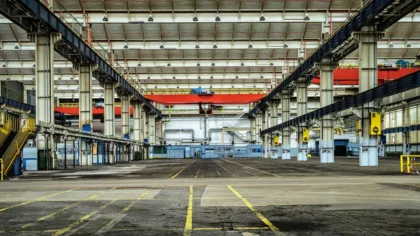Accelerate Productivity in 2025
Reignite Growth Despite the Global Slowdown
Emerging technologies are revolutionizing industries, demographic shifts are reshaping cities and markets, and the global response to climate change is redefining business strategies. These megatrends are no longer theoretical; they are tangible forces transforming how we work, live, and engage with the world.
This in-depth analysis examines 12 key global megatrends, highlighting their impact on businesses. Designed for innovators and business leaders, it serves as a guide to navigating industry shifts and unlocking future success.
Here is what you can expect:
- 12 Emerging Global Megatrends [2025 – 2030]
- Impact of Megatrends across 10 Industries
- Future Outlook and Developments
- 6 Strategies for Businesses
This article was last updated in January 2025.
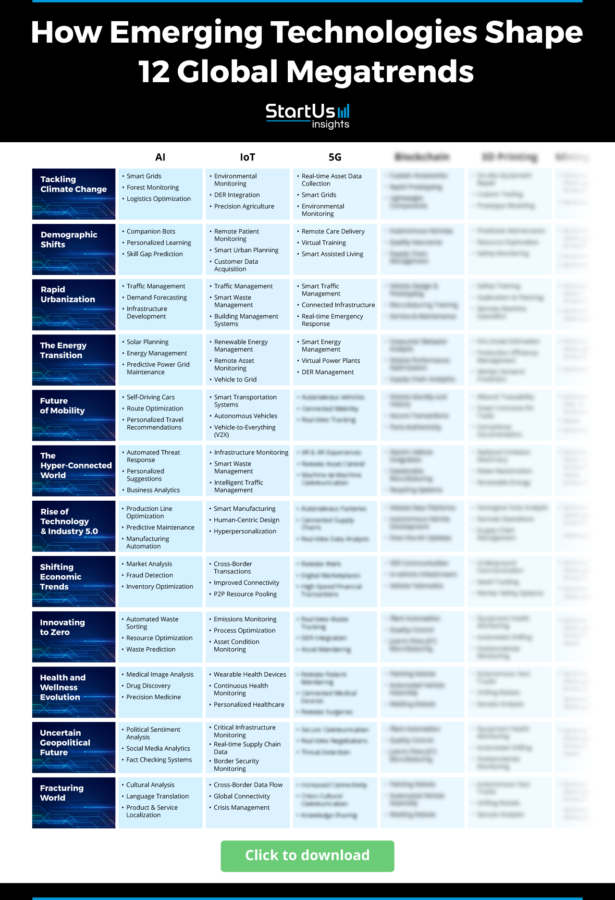
What are the Current Global Megatrends? [2025 – 2030]
This executive summary captures the essence of the discussed global mega trends, highlighting their significant impact on the world’s economy, society, and technological landscape. It is also a roadmap to anticipate their long-term implications on your professional landscape.
Use this resource to make informed decisions, identify emerging opportunities, and strategically position your organization at the forefront of innovation.
- Tackling Climate Change: A critical mission leveraging innovations in renewable energy, carbon capture, and circular economies. Key initiatives like the European Green Deal are driving the future towards a climate-positive era.
- Demographic Shifts: Significant changes, including aging populations and urbanization, are transforming economies. The Asia Pacific’s burgeoning silver economy and growing focus on upskilling are notable trends.
- Rapid Urbanization: The drive towards smart, sustainable cities is underscored by the necessity for green infrastructure and advanced construction techniques. Initiatives like India’s Smart Cities Mission highlight this trend.
- The Energy Transition: Moving towards renewable sources, policies like the Paris Agreement and the European Union’s Fit for 55 Package are key accelerators.
- Future of Mobility: Innovation in electric and autonomous vehicles, alongside shared mobility, is revolutionizing transport. The EU’s Green Mobility Initiative and China’s NEV Policy, for instance, are pivotal.
- Hyper-Connectivity: Advances in 5G, the Internet of Things (IoT), and AI are facilitating unprecedented levels of connectivity and efficiency. Projects like South Korea’s 5G expansion and Amsterdam’s Smart City initiative exemplify this trend.
- Rise of Technology & Industry 5.0: The shift towards human-centered manufacturing is redefining production. The EU’s Industry 5.0 Strategy and Japan’s Society 5.0 Initiative are leading the way.
- Shift in Global Economic Power: Emerging markets are reshaping the economic landscape. Initiatives like China’s Belt and Road and the African Continental Free Trade Area play significant roles.
- Innovating to Zero: Aiming for zero net energy buildings and waste, this trend emphasizes sustainable practices across industries. San Francisco’s Zero Waste City and Apple’s Net-Zero Commitments are examples of this megatrend.
- Health and Wellness Evolution: The shift towards proactive healthcare and wellness, supported by wearable devices and telehealth, is transforming perspectives on well-being.
- Social Instability: Addressing the complexities of geopolitical volatility, initiatives like the UN’s peacekeeping operations and the P5+1 negotiations with Iran are crucial.
- Fracturing World: The increasing divides in the global landscape call for initiatives promoting unity and collaboration, like the Internet Governance Forum.
How Can Businesses Leverage these Megatrends?
Companies should integrate green practices and novel technologies, adjust to demographic and social preferences, and develop resilient supply chains in response to emerging megatrends. They should also optimize offerings for urban and mobile lifestyles and prioritize ethical behaviors to stay competitive.
How We Researched and Where this Data is from
- Analyzed 3100+ industry reports on recent innovations to gather relevant insights.
- Cross-checked this information with external sources for accuracy.
- Leveraged the StartUs Insights Discovery Platform, an AI- and Big Data-powered Innovation Intelligence Platform covering 4.7M+ emerging companies and over 20K+ trends & technologies worldwide to:
- Confirm our findings using the Trend Analysis feature and
- Find emerging tech companies for the “Spotlighting an Innovator” sections.
So, let’s look into the future of the world and see how it impacts every industry, big or small.
12 Megatrends Impacting Businesses Globally in 2025
We explore each trend in-depth, providing actionable insights into how they’re transforming economies, societies, and the global landscape.
Through this analysis, we give you a thorough understanding of these powerful shifts, enabling you to confidently navigate the challenges and opportunities they present.
This section provides you with:
- A deep dive into each megatrend,
- A concise overview of their economic impacts & financial forecasts,
- Technologies advancing each megatrend,
- An innovative startup in the field, as well as
- Key initiatives propelling the trend forward.
1. Tackling Climate Change: A Critical Mission for Global Sustainability
Taking action to address global climate change is vital as its impacts become more apparent worldwide. The goal is to cut emissions while building a robust, sustainable future for everybody.
This trend includes a broad spectrum of tactics and technologies that enable organizations to shift toward climate-positive operations and adjust to the changes that have already occurred.
Economic Impacts & Financial Forecasts
- 2025: The Brainy Insights projects a USD 2 trillion green bond market by 2025.
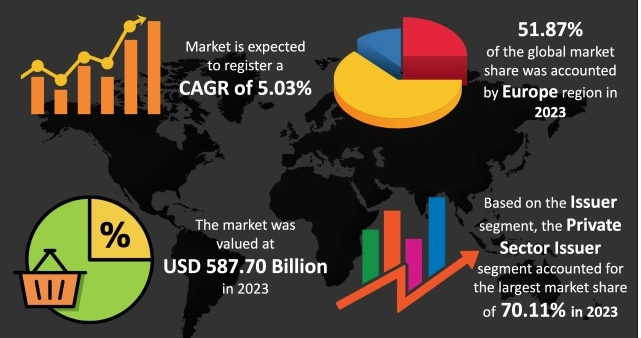
Source: The Brainy Insights
- 2030: The Global Commission on the Economy and Climate projects that strong climate action will bring around USD 26 trillion in economic gains.
Core Technologies Connected to Climate Technologies
- Renewable Energy: This category includes a range of technologies, like geothermal energy, biofuels, and solar power, to produce power.
- Carbon Capture and Storage (CCS): Such solutions capture carbon emissions for storage or convert them into usable products.
- Circular Economy Models: Prioritize recycling, waste minimization, and sustainable consumption for a sustainable future.
- Advanced Climate Modeling: Utilizes AI and data analysis to forecast climate patterns, guide policy choices, and improve our readiness for upcoming climate-related issues.
Spotlight on a Climate Innovator: Humify
Humify is a German company that is reversing climate change. Its hydrothermal humification process converts biomass into a humic substance to capture and store carbon and reverse soil degradation. This approach accelerates CO2 sequestration, increases soil fertility, and restores the soil microbiome.

Key Initiatives in Climate Action
- The European Green Deal: An ambitious plan to make Europe climate neutral by 2050. It calls for investment in eco-friendly technology to encourage industrial innovation and implement cleaner transportation.
- IKEA’s Sustainable Operations: IKEA pledges to achieve climate positivity by 2030. The firm intends to use sustainable products, forestry initiatives, and renewable energy to achieve this.
- Google’s Renewable Energy Commitment: The digital behemoth’s pledge to use only carbon-free energy by 2030. It will be driven by investments in wind and solar power projects.
In confronting the multifaceted challenge of climate change, businesses play a pivotal role in the transition towards a sustainable future. The imperative for companies to integrate renewable energy solutions, adopt green practices, and champion innovation.
This megatrend also calls for immediate action and demands a sustained commitment to ecological sustainability in corporate strategies. By uniting in this endeavor, businesses can lead by example, ensuring their growth aligns with the planet’s health.
2. Demographic Shifts: Navigating a World of Change
Significant demographic changes are taking place around the world, drastically altering economies and civilizations. These shifts include urbanization and migration patterns, as well as aging populations and youth bulges in different areas.
Moreover, they are generating fresh chances and difficulties. For sustainable development and economic progress, it is essential to comprehend these changes and make necessary adjustments.
As a result, developing industries like robots and the expanding silver economy are becoming popular. Consider the Asia Pacific region’s silver economy industry which is expected to reach a significant value of USD 4.6 trillion by 2025. A further indication of the trend’s importance is the growing focus on longevity technology.
Economic Impacts & Financial Forecasts
- 2025-2030: The UN projects that, with significant growth in developing nations, the world’s population will reach 8.5 billion by 2030. Changes in the workforce and consumer markets are predicted to result from this transition.
- 2029: Fortune Business Insights projects that the industrial automation industry will grow to USD 395.09 billion.
Core Technologies addressing Demographic Shifts
- Telehealth and Remote Patient Monitoring: Healthcare professionals can now monitor and treat elderly patients remotely, increasing accessibility to care
- Online Learning Platforms: Encourage lifelong learning, which is becoming more and more crucial as sectors and vocations evolve.
- Networking Platforms: Facilitate interaction, teamwork, and the production and distribution of material among younger people.
- Autonomous Vehicles: Increase mobility for the elderly and disabled as well as in rural areas.
Spotlight on an Innovator: La Casa
La Casa is an Irish company that offers remote patient monitoring for elderly care. Its sensors and electrical appliances collect data at the residence and send it to a remote server. An evidence-based machine learning model then assesses the patient data to derive insights, offer recommendations, and ensure timely interventions. This information allows the elderly to be more independent and care providers to ensure effective outpatient management.
Key Initiatives in addressing Demographic Shifts
- Singapore’s Healthcare 2020 Masterplan: The elderly population of Singapore will benefit from more affordable treatment and improved infrastructure.
- IBM’s Smarter Cities Challenge: Provides cities with access to IBM’s top experts to solve critical challenges, including those posed by demographic changes.
- Canada’s Express Entry program: Reduces labor shortages and demographic issues by facilitating the entry of qualified professionals.
Demographic changes are transforming the global landscape, offering businesses a spectrum of challenges and opportunities. With aging populations and burgeoning youth demographics in others, businesses must pivot and adapt to remain competitive and relevant.
Additionally, tailoring products, services, and employment practices to meet the varying needs of these diverse age groups. This is essential for fostering economic resilience and ensuring market relevance. By proactively responding to demographic trends, businesses can unlock new markets, innovate in product development, and cultivate an inclusive workforce.
3. Rapid Urbanization: Reshaping the Human Geography
Overcrowding leads to significant challenges, including strained infrastructure, diminished quality of life, and increased environmental pollution. The increasing density of people living in urban areas is thus driving a need for creative urban solutions.
The goal is to use this expansion to construct more intelligent, environmentally friendly cities that sustain their current population. Therefore, this movement encompasses a broad range of innovations and inventive strategies meant to make urban growth advantageous and sustainable.
Economic Impacts & Financial Forecasts
- 2040: The World Economic Forum predicts that there will be a USD 15 trillion infrastructure gap globally.
- 2050: UN estimates 2.5 billion people will be added to urban areas, demanding massive investments in urban infrastructure.
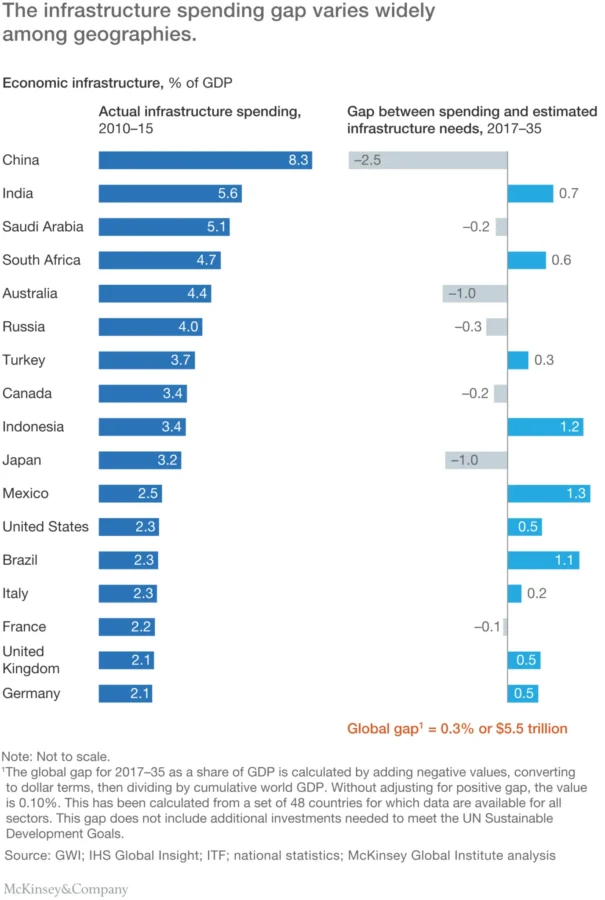
Credit: McKinsey & Company
Core Technologies Connected to Urbanization
- Connected Cities: Smart grids, IoT devices, and urban informatics are all part of connected cities, which build tech-driven, productive metropolises.
- Green Infrastructure: Urban gardens, green roofs, and sustainable drainage systems are making cities more sustainable.
- Transportation Innovations: Managing the mobility demands of expanding urban populations depends on advances in EVs, autonomous vehicles, and effective mass transit systems.
- Advanced Construction Techniques: 3D printing, modular architecture, and environmentally friendly materials satisfy the pressing need for infrastructure and urban housing.
Spotlight on an Urban Innovation Pioneer: Lyne Technologies
Lyne Technologies is a Romanian company that aids in air mobility planning. Its proprietary software allows urban planners to plan, evaluate, and design custom vertiport solutions for drones and eVTOL landing.
Moreover, the software simplifies obstacle assessment, area, and taxiway customization, as well as includes aeronautical charts. These features allow urban planners, architects, and real estate firms to better plan air mobility infrastructure while optimizing space utilization.
Key Initiatives in Urban Development
- The Smart Cities Mission of India: Its goal is to create 100 smart cities nationwide to boost the nation’s economy and standard of living.
- Singapore’s Green Plan 2030: A national campaign to promote zero waste and more green places as well as sustainable development.
The surge in urbanization is reshaping the market landscape. This presents businesses with unique challenges and opportunities to innovate in the fields of housing, transportation, and infrastructure.
The future also demands that companies contribute to city development where growth and quality of life go hand in hand. By investing in and providing smart, sustainable solutions, businesses play a crucial role in building accommodating and efficient urban environments.
4. The Energy Transition: Powering Towards a Sustainable Future
The world’s energy system is radically changing as it moves away from fossil fuels and toward cleaner, renewable energy sources. This shift is a key megatrend pushed forward by the pressing need to mitigate climate change and cut carbon emissions. To provide energy security and environmental stewardship for future generations, renewables are transforming economies, industries, and everyday life.
Economic Impacts & Financial Forecasts
- 2025: BloombergNEF projects that spending in clean energy supply chain may total USD 259 billion.
- 2025-2030: According to Next Move Strategy Consulting, the renewable energy market will reach USD 2.02 trillion.

Credit: Next Move Strategy Consulting
Core Technologies Driving the Energy Transition
- Solar & Wind Power: Leading the way in renewable energy, solar and wind power are becoming more cost-effective and are gaining worldwide traction.
- Energy Storage Solutions (ESS): For renewable energy sources to be dependable and grid-compatible, batteries and other storage technologies are essential for reducing intermittency.
- Smart Grids and Digitalization: By optimizing energy distribution and facilitating renewable integration, smart grids improve grid management and efficiency using cutting-edge technologies.
- Hydrogen & Fuel Cell Technologies: Hydrogen fuel cells are decarbonizing transportation and industrial operations, providing a clean option for industries difficult to electrify.
Spotlight on an Energy Innovator: Hysun
Hysun is a Spanish company advancing the hydrogen economy with its off-grid renewable hydrogen generation process. It utilizes photo-thermo-catalyst and concentrated solar energy technology to produce hydrogen and oxygen without gas separation, emphasizing efficiency and scalability. Moreover, the company’s technology reduces capital and operations expenses (CAPEX and OPEX).
Key Initiatives Accelerating the Energy Transition
- The European Union’s Fit for 55 Package: A component of the European Green Deal, this initiative seeks to cut GHG emissions by at least 55% by 2030.
- China’s Carbon Neutrality Pledge: China has committed to being carbon neutral by 2060, despite being the greatest emitter of GHGs globally.
- The Paris Agreement: Many countries have established net-zero emissions as their goal, and all nations are pledging to reduce carbon emissions.
The shift towards a sustainable energy paradigm is positioning businesses at the heart of a critical economic and societal transformation. Beyond environmental imperatives, this global shift represents a profound opportunity for crafting a cleaner, more sustainable future.
Through strategic investments in renewables, adherence to progressive regulations, and collaborative initiatives, businesses are driving the transition to a greener energy ecosystem. This movement aligns with ecological goals and also opens new avenues for business innovation and competitive advantage.
5. Future of Mobility: Revolutionizing How We Move
Companies, like Tesla and Cisco, are guiding us towards a future where mobility is more intelligent, eco-friendly, and productive. Converging technical innovation, environmental concerns, and shifting consumer expectations are the driving forces behind this revolution.
The way we transport people and products is changing as cities develop and the world’s population rises. And, advanced in mobility have the potential to improve accessibility, cut emissions, and ease traffic.
Economic Impacts & Financial Forecasts
- 2025: According to Virta Global, 25% of new vehicle purchases will be EVs.
- 2025-2032: Polaris Market Research expects the market for shared mobility will reach a value of USD 815.14 billion.
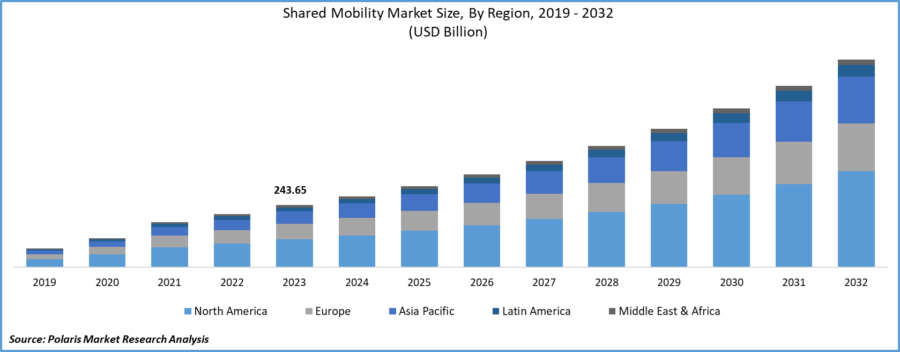
Credit: Polaris Market Research Analysis
Core Technologies Driving the Future of Mobility
- Electric Vehicles: A wider range of people are finding EVs to be more feasible and accessible. This is because of advances in battery technology and charging infrastructure.
- Autonomous Driving: By utilizing AI, machine learning, and sensors, self-driving cars save costs, minimize accidents, and enhance traffic flow.
- Connected Vehicles: IoT and connectivity technologies allow cars to talk to infrastructure and to each other, which increases road safety.
- Shared Mobility Platforms: Reduce vehicle ownership and city traffic by enabling ride-hailing, car-sharing, and micro-mobility services (such as scooters and e-bikes).
Spotlight on a Mobility Innovator: SUTECH OtonomTeknoloji
SUTECH OtonomTeknoloji is a Turkish company that offers sustainable waterway mobility. Its autonomous vehicles for urban water transport provide solutions to traffic congestion as well as high fuel and operational costs. The company’s autonomous vessels are efficient, safe, and environmentally friendly, contributing to sustainable urban development.
Key Initiatives Accelerating the Future of Mobility
- EU’s Green Mobility Initiative: Encourages the switch to EV, the growth of sustainable public transportation, and the promotion of walking and cycling. The goal is to reduce transportation-related emissions by 90% by 2050.
- China’s New Energy Vehicle (NEV) Policy: Aims to clean up the domestic auto industry by 2030 by providing incentives to EV makers and consumers.
- Smart Mobility 2030, Singapore: Uses intelligent transport systems (ITS) to change the city-state’s transportation infrastructure.
For businesses, the future of mobility heralds a new era of sustainable, efficient, and inclusive transportation solutions. Moreover, this evolution is about redefining mobility as a catalyst for fostering a more connected and accessible world. By prioritizing groundbreaking technologies and fostering global partnerships, novel mobility companies make the mobility landscape align with broader societal goals.
6. The Hyper-Connected World: Weaving a Digital Fabric for the Future
Technology is seamlessly integrated thanks to the widespread availability of internet access and the advancements in communication technologies. For instance, 5G, LoRaWAN, and IoT are changing how we communicate, work, and live.
This megatrend is paving the way for previously unheard-of levels of creativity, efficiency, and international collaboration. For this, data takes on the role of money and connection becomes a basic necessity.
Economic Impacts & Financial Forecasts
- 2025: MarketsandMarkets expects the 5G core market to grow to USD 9.49 trillion, spurring innovation across industries including manufacturing and healthcare.
- 2025-2030: IoT market size projections for 2025 – 2030 show a 26.1% compound annual growth rate (CAGR) of USD 3352.97 billion by 2030.
Core Technologies Driving the Hyper-Connected World
- 5G Networks: Provide more capacity, reduced latency, and quicker speeds. As the foundation of next-generation communication, 5G allows for real-time, remote medical operations as well as driverless cars.
- IoT: By bridging the physical and digital realms, IoT devices offer data-driven insights that enhance decision-making and streamline procedures.
- AI & ML: Examine massive datasets produced by networked devices to find trends, forecast results, and automate repetitive jobs.
Spotlight on a Connectivity Tech Innovator: Novicod
Novicod is an Israeli company advancing embedded connectivity. Its embedded RF communicators are printable within materials such as paper, cartons, graphic films, and textiles. This technology simplifies item tracking and monitoring, enhancing the IoT industry with a focus on printed packaging and labels. This solution, in turn, increases global supply chain visibility and transparency.
Key Initiatives Accelerating the Hyper-Connected World
- South Korea’s 5G Network Expansion: The government is actively building its 5G infrastructure in partnership with big telecom firms.
- Amsterdam’s Smart City Project: It is a notable example of a cutting-edge endeavor to use IoT to revolutionize urban living.
- Project ECHO: A tele-mentoring initiative from the US linking primary care doctors to democratize access to high-quality treatment and medical information.
Businesses are the catalysts transforming connectivity into a powerful tool for economic growth, innovation, and creating an inclusive society. Companies are leveraging digital platforms, cloud computing, IoT, and more to break down geographical barriers. Using these technologies, they deliver products and services that reach global markets with unprecedented speed and efficiency.
Connectivity also enables businesses to enhance operational efficiency, personalize customer experiences, and ensure secure transactions. At the same time, the responsibility lies with enterprises to lead ethically and ensure equitable and private technology access.

7. Rise of Technology & Industry 5.0: Personalizing the Future of Manufacturing
Industry 5.0 and other technological developments, such as generative AI, are moving the emphasis from mass manufacturing to mass customization. They are fusing intelligent technology with human creativity.
The focus of this new phase is on human-centered, sustainable manufacturing techniques that leverage robots, AI, IoT, and more. These put the health of the environment first while improving productivity and worker safety.
Economic Impacts & Financial Forecasts
- 2025: Precedence Research projects that the smart manufacturing market will be worth USD 353.23 billion.
- 2025-2032: Estimates for the Industry 5.0 market place it at a compound annual growth rate of 18%, or USD 658.4 billion.
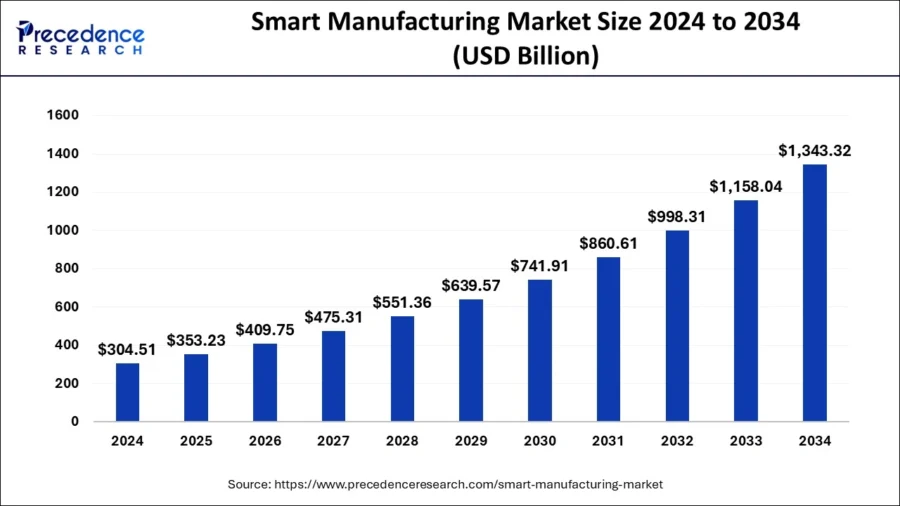
Credit: Precedence Research
Core Technologies Driving Industry 5.0
- Collaborative Robots (Cobots): Assist people in creating a more secure and adaptable work environment while increasing output.
- AI & ML: Increase productivity and decrease downtime by streamlining manufacturing procedures, enhancing quality assurance, and enabling predictive maintenance.
- Advanced Materials: Among other things, biodegradable materials and smart textiles allow for more environmentally friendly production and novel product features.
- Digital Twins: By simulating, analyzing, and optimizing processes prior to implementing them, virtual copies of physical systems reduce costs.
Spotlight on an Industry 5.0 Innovator: INDISE
INDISE is a Swedish company that develops AI-based software for the manufacturing industry. Its product lineup includes solutions for production logistics, assembly control, quality control, predictive maintenance, and more.
For example, the company’s non-invasive AI platform checks incoming goods and verifies parts in production automatically. It also monitors tolerances and deviations, detects wear and tear tools, and increases supply chain transparency. This way, INDISE supports workers to improve efficiency and mitigate labor shortages.
Key Initiatives Accelerating Industry 5.0
- The European Union’s Industry 5.0 Strategy: Supports a digital, competitive, and sustainable economy by investing in technologies that empower workers and lessen environmental impacts.
- Japan’s Society 5.0 Initiative: Uses innovations in manufacturing and services to address social issues by fusing technology with facets of daily life.
As businesses navigate the new wave of Industry 5.0 and emerging technologies, they are redefining the interplay between humans and machines. This shift ushers an era of enhanced production capabilities, where customization, sustainability, and resilience become the cornerstones of industrial operations.
Additionally, this leads to a challenge in harmonizing technological advancements with workforce development and ethical considerations. As we move forward, businesses play a crucial role in shaping an industrial ecosystem that values innovation and human-centric approaches.
8. Shift in Global Economic Power: Redefining the World Economy
Evolutionary patterns of the economy capture the ever-changing dynamics of the world economy. The importance of emerging markets is also changing the economic power dynamics. Rapid industrialization, technological advances, changing demographics, and the growing clout of economies in Asia, Africa, and Latin America are the main forces behind this transition.
These areas contribute to a more multipolar global economy as their economies expand. Moreover, this puts the old economic hierarchy to the test and presents fresh possibilities. This shift in economic power also causes difficulties for governments and corporations throughout the globe.
Economic Impacts & Financial Forecasts
- 2025: OECD’s Economic Outlook projects a steady global GDP growth of 3.2% in 2025, with stronger performance in emerging markets than advanced economies.
- 2030: Goldman Sachs Research expects the stock market capitalization of emerging markets to reach 35% of the global total.
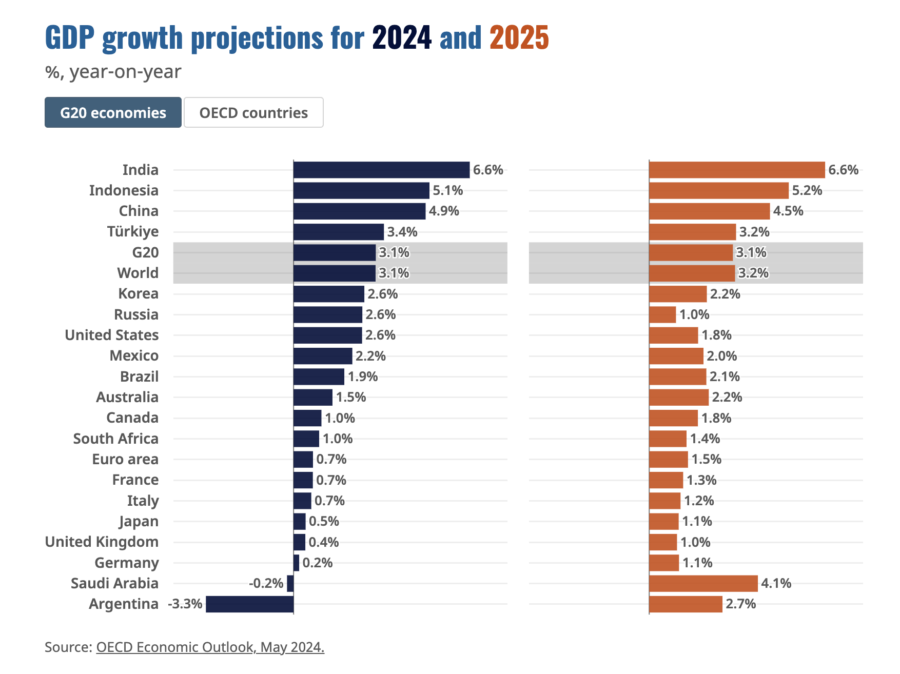
Credit: OECD Economic Outlook
Core Technologies and Practices regulating Global Economic Shifts
- Digital Financial Platforms: Accelerate economic growth in developing regions, contributing to a more balanced distribution of global economic power.
- Blockchain: Facilitates smoother cross-border transactions, enabling emerging economies to participate more fully in the global economy.
- AI & Big Data: Allows nations to predict economic shifts, optimize resource allocation, and implement policies that support sustainable growth.
Spotlight on an Innovator: Metaco Intelligence
Metaco Intelligence is a Singapore-based company that offers Zoth, an on-chain marketplace for global trade finance. It allows businesses in emerging markets to receive capital for growth and expansion. This way, Zoth connects lenders and businesses while providing mutualized real-world collateral through tokenization. It also adapts risk mitigation strategies across the credit cycle.
Key Initiatives Reflecting Economic Trends
- Belt and Road Initiative (BRI): China’s bold global development plan intends to improve regional connectivity to boost international commerce and economic dynamism.
- African Continental Free Trade Area (AfCFTA): Promotes intra-African trade and stimulates economic growth by establishing the largest free trade area in the world.
- Brazil’s Investment Partnership Program (PPI): Boosts productivity and promotes the country’s economy by lowering investment obstacles and improving infrastructure.
The shift in global economic power offers opportunities and challenges as emerging markets gain prominence and redefine economic paradigms. For businesses, investors, and policymakers, understanding and adapting to this shift is crucial.
As these developing economies assert their influence, stakeholders across the spectrum must strategically navigate the evolving global order. The ability to adapt to and capitalize on these changes will also be key to thriving in a dynamically restructured economic environment.
9. Innovating to Zero: Pioneering a Zero-Impact Future
Among its many objectives, this segment of technologies works towards zero net energy buildings, zero waste, and zero carbon emissions. This pattern shows an increasing willingness on the part of businesses, governments, and communities.
They, together, confront the pressing issues of resource depletion, environmental degradation, and climate change. Businesses are also using radical ideas and climate-positive practices to achieve this.
Economic Impacts & Financial Forecasts
- 2025: According to Statista, the market for renewable energy would grow to USD 2.15 trillion.
- 2030: Reaching the Sustainable Development Goals (SDGs) of the UN may lead to the creation of USD 12 trillion in new business possibilities across industries.
Core Technologies and Practices Driving Innovating to Zero
- Renewable Energy: The switch to zero-carbon energy production depends on integrating solar, wind, hydro, and other renewable energy sources.
- Carbon Capture and Utilization (CCU): Technologies collect carbon dioxide emissions from industrial sources and store or transform them into useful products.
- Green Building Technologies: Employ sustainable materials, intelligent energy management systems, and zero net energy buildings to optimize energy consumption.
- Circular Economy: Minimizes waste by designing products and implementing business strategies that encourage resource recovery, recycling, and reuse.
Spotlight on a Net-Zero Innovator: n0c tech
n0c tech is a US-based company that decarbonizes industries using its proprietary electric carbon capture plant. The plant collects CO2 from various sources and features remote monitoring and control options, enabling real-time performance tracking and control. This allows coal and steel plants as well as ships to capture emissions at the source with increased energy efficiency.
Key Initiatives Accelerating Innovating to Zero
- San Francisco’s Zero Waste City Project: The goal of the city’s recycling and composting initiatives is to divert over 80% of its waste from landfills by 2030.
- Apple’s Net-Zero Commitments: By 2030, Apple wants to be carbon neutral throughout its product life cycle, manufacturing supply chain, and corporate operations.
The ‘innovating to zero’ philosophy marks a pivotal shift for businesses in how economies operate, products are designed and used, and energy is generated and consumed. As momentum builds, it opens fresh avenues for investment, collaboration, and creativity.
Innovating to zero solutions, in turn, urges companies to rethink their strategies and operations. This transformative approach not only aligns with ecological goals but also propels businesses toward innovative, sustainable growth.
10. Health and Wellness Evolution: Transforming Perspectives on Well-being
Advances in healthcare enable proactive, preventative, and individualized treatment, improving health, well-being, and quality of life globally. The current paradigm in healthcare represents a transition from reactionary to comprehensive methods.
This is driven by developments in technology, shifting demographics, and increased awareness of mental health. Moreover, the growing emphasis on healthcare and wellness represents a holistic understanding of health. This includes physical health and also mental, emotional, and environmental well-being.
Economic Impacts & Financial Forecasts
- 2025: According to Statista, the wellness industry will be worth USD 7.32 trillion.
Global Wellness Market Size
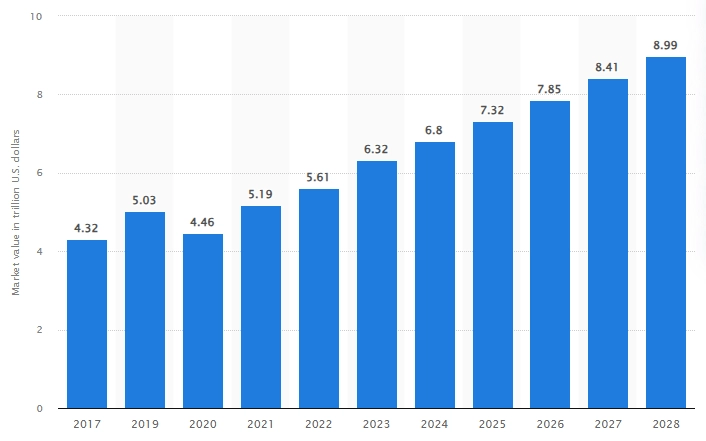
Source: Statista
- 2025-2037: At a CAGR of 15.3% throughout the projected period, the digital health market is predicted to reach USD 1.98 trillion by 2037.
Core Technologies and Practices Driving Health and Wellness Evolution
- Wearable Healthcare Devices: Track exercise activities, monitor vital signs, and provide individualized health insights.
- Telehealth & Telemedicine: Increase access to treatment, especially in impoverished areas, and provide quick and effective medical consultations.
- Mental Health Apps: Offer resources for stress reduction, meditation, and treatment as well as other mental health issues.
- Personalized Nutrition & Medicine: Developments in genomics and biotechnology allow customized treatment regimens and diets.
Spotlight on a Wellness Innovator: Glidance
Glidance is a US-based company that makes a self-guided mobility aid. It allows people with visual impairment to walk independently, avoid obstacles, and find doors, elevators, stairs, and more. For this, Glidance utilizes cameras and sensors in its mobility aid. Moreover, it supports precision indoor and outdoor navigation, personalized routes, and live remote assistance.
Key Initiatives Accelerating Health and Wellness Evolution
- Brazil’s Family Health Strategy: Aims to increase access to healthcare by offering community-based primary healthcare throughout the country.
- Australia’s Mental Health Policy: Seeks to lessen stigma, increase access to treatments for those with mental health disorders, and enhance mental health outcomes.
- Google’s Wellness and Fitness Programs: Offers communal bicycles, health workshops, and on-campus fitness centers as part of its wellness and fitness programs.
The health and wellness evolution is revolutionizing the medical industry and individual health practices. This megatrend also places a renewed emphasis on mental well-being, balanced living, and technological integration.
For businesses, this burgeoning trend offers an opportunity to enhance the quality of life for patients and transform healthcare delivery. As companies adapt to and drive this shift, they play a pivotal role in shaping a future where health and wellness are seamlessly integrated into every aspect of daily life.
11. Social Instability: Navigating Through Turbulence
Uncertainty in the geopolitical future draws attention to the increasing complexity and volatility of the world environment. It is characterized by political upheavals, economic inequality, environmental disasters, and changing power dynamics.
This trend captures the difficulties and uncertainties that enterprises, governments, and people must deal with during the period of unpredictable and fast change. Strategies and policies to confront geopolitical conflicts, social unrest, and economic instability emphasize resilience, adaptation, and strategic foresight.
Economic Impacts & Financial Forecasts
- 2025: The yearly cost of cybercrime worldwide will reach USD 10.5 trillion.
- 2025-2030: According to the IEA, geopolitical unrest in major oil-producing areas may cause oil prices to rise. Moreover, long-term stability may not occur until the early 2030s.
Core Technologies and Practices reducing Social Instability
- Civic Engagement Platforms: Allow citizens to participate in governance procedures like policy formulation and the establishment of feedback systems.
- Blockchain: Enables safe and transparent data management and transaction recording in voting systems, public registries, and supply chains.
- AI in Public Safety: AI-powered monitoring and proactive enforcement instruments detect possible hazards and optimize resources.
Spotlight on a CivicTech Innovator: Democracia en Red
Democracia en Red is an Argentine company that develops digital platforms for citizen participation. Its product lineup includes platforms for participatory management, public consultation, voting, and more. They allow governments and public institutions to increase civic engagement and deliver decision-making power to the people.
Key Initiatives Addressing the Uncertain Geopolitical Future
- UN’s Peacekeeping Operations: MINUSMA, for instance, assists Mali’s democratic processes and manages security-related duties to keep the nation stable.
- P5+1 Negotiations with Iran: JCPOA restricts Iran’s nuclear capabilities in exchange for the easing of economic sanctions. This is an example of how diplomacy plays a role in tackling nuclear non-proliferation.
In the face of social instability and an uncertain geopolitical landscape, global leaders, corporations, and communities must act with foresight and strategic acumen. This megatrend challenges us to rethink approaches to diplomacy, champion multilateral cooperation, and commit to social equality and sustainability.
Moreover, tackling this complex issue demands collective action, inviting businesses to lead in building resilient, prosperous communities. By embracing innovative solutions and fostering collaboration, emerging companies are moving societies toward a more stable and promising future.
12. Fracturing World: Navigating the Divides of a Fragmented Global Landscape
There is a widening gap and increasing fragmentation in the geopolitical, economic, social, and digital domains. Moreover, this tendency challenges the idea of a single global community by reflecting a global environment. It is characterized by rising nationalism, protectionism, digital polarization, and socioeconomic inequality.
Moreover, a divided globe makes it difficult to promote international cooperation and togetherness as nations and groups struggle with internal and external pressures. These fractures can show up as trade wars, political disputes, cultural differences, and digital divides, among other manifestations.
Economic Impacts & Financial Forecasts
- 2025-2026: Global economic growth is expected to maintain a steady pace of 2.8% annually until 2026, with regional variations influencing trade dynamics.
- 2030: With large economies like China, India, and others exercising more influence, the global economy is expected to have a more multipolar structure.
Core Technologies and Practices mitigating the Effects of Fracturing World
- Digital Diplomacy Platforms: Provide direct communication between countries and international organizations and the dissemination of vital information.
- Blockchain: By guaranteeing the integrity of elections, public contracts, and agreements, its transparent and safe ledger system improves governance.
- Cross-Border eCommerce: Promotes economic inclusion and interdependence by facilitating cross-border trade, offering small and medium-sized businesses access to international markets.
- AI-Powered Translation: Facilitate communication and understanding between speakers of various languages, hence advancing international trade, diplomatic relations, and intercultural harmony.
Spotlight on an Innovator: HerVest
HerVest, a Nigeria-based startup, enables financial inclusion for African women through a gender-lens investment framework. The platform provides features such as fee-free in-app transfers and zero withdrawal charges, ensuring seamless financial transactions. Further, it enables users to invest in dollar-denominated assets, earning returns in the same currency, thereby offering a hedge against local currency fluctuations.
The platform also integrates tools for financial personality assessment and access to low-risk investment opportunities. This strategic approach not only enhances individual financial growth but also supports the broader goal of fostering inclusive and sustainable economic development in emerging markets.
Key Initiatives to Mend a Fragmenting World
- China’s Belt and Road Initiative (BRI): Asia, Africa, and Europe see increased trade and economic growth with China’s BRI.
- Internet Governance Forum (IGF): Focuses on cybersecurity, digital inclusiveness, and the direction of internet governance. It assists the UN Secretary-General in carrying out the directive from the World Summit on the Information Society (WSIS).
In a world increasingly marked by divisions, businesses play a crucial role in bridging gaps and fostering unity. For this, companies leverage innovative strategies in community engagement, governance, and international cooperation.
Moreover, emphasizing unity, equity, and collective well-being is essential in navigating the challenges of a fracturing world. By transforming divides into opportunities, companies are strengthening global solidarity and building a resilient future.
Impact of Emerging Megatrends on 10 Industries Globally
The influence of worldwide megatrends on many sectors emphasizes the interdependence of societal movements, technical progress, and economic metamorphoses. Specific megatrends are altering sectors in the following ways:
Manufacturing
- Rise of Technology & Industry 5.0: Quicken automation and intelligent production by combining robots, IoT, and AI to improve productivity and personalization.
- Innovating to Zero: Encourages the creation of eco-friendly products and sustainable manufacturing techniques to reduce their negative effects on the environment.
Energy
- The Energy Transition: Marks a significant shift from fossil fuels to renewable energy sources, driven by the need to combat climate change and achieve energy sustainability.
- Innovating to Zero: Achieve net-zero emissions in the energy sector by utilizing advances in carbon capture and storage (CCS), energy efficiency, and energy storage technologies.
Logistics
- The Hyper-Connected World: Enhances efficiency and transparency by utilizing blockchain and IoT to enable sophisticated tracking and optimization of logistical operations.
- Future of Mobility: Uses drones and driverless cars to transform delivery and transportation, cutting expenses and greenhouse gas emissions.
Construction
- Tackling Climate Change: Needs the use of sustainable materials and green building techniques to lower the carbon emissions produced by the construction sector.
- Rapid Urbanization: Meets the needs of an expanding urban population by using prefabricated and modular structures, among other novel construction techniques.
Food & Beverage
- Demographic Shifts: Changes in customer tastes and dietary requirements due to demographic shifts force the sector to modify its supply networks and products.
- Innovating to Zero: Promotes waste reduction across the whole food production and consumption cycle as well as sustainable agricultural techniques.
Pharmaceuticals
- Health and Wellness Evolution: Drives the creation of digital health solutions and tailored treatment to meet the needs of a health-conscious society.
- Rise of Technology & Industry 5.0: Uses AI and big data in medication research and discovery to accelerate the time and effectiveness of new treatments in the market.
Retail
- The Hyper-Connected World: Influences the rise of e-commerce and the use of AI in tailored shopping experiences, satisfying the needs of customers for ease and personalization.
- Shifting Economic Trends: To handle changes in the economy and customer behavior, omnichannel retail strategies and flexible supply chains are essential.
Finance
- The Hyper-Connected World: Financial transactions are now more accessible, safe, and efficient thanks to fintech innovations like mobile payments and blockchain.
- Uncertain Geopolitical Future: As institutions negotiate the complexity of a multipolar economic world, there is a greater emphasis on cybersecurity and financial stability.
Healthcare
- Health and Wellness Evolution: Prompts the growth of wearable health technology, telemedicine, and preventative care services in response to a more comprehensive knowledge of health.
- Demographic Shifts: Uses medical innovation to meet the healthcare demands of an aging population and adjust to the prevalence of chronic diseases.
Agriculture
- Tackling Climate Change: Requires precision agricultural techniques and technology to increase climate variability resistance and guarantee sustainable food production.
- The Energy Transition: Refers to the move away from fossil fuels and toward renewable energy sources in agricultural operations, which also results in a smaller carbon impact.
These examples show how global megatrends are providing possibilities for sectors to lead in sustainability, technology, and social responsibility, while simultaneously posing challenges for them to innovate and adapt.
Future Predictions and Developments
The concrete effects of global megatrends on our everyday routines, places of employment, and communities are becoming more and more obvious as time goes on. Here are some more specific forecasts and advancements that should come to pass by 2030 and influence our world:
Widespread Adoption of Electric Vehicles
According to predictions, electric cars will rule the automobile industry by 2030, drastically lowering carbon emissions and reliance on fossil fuels. Big cities will increase the number of charging stations in their networks, increasing the accessibility and practicality of EVs.
In addition to enhancing air quality, the change will accelerate advancements in battery technology and the use of renewable energy sources.
Zero-Waste Lifestyle Mainstreaming
Raising awareness of environmental sustainability will propel the push towards zero-waste living beyond specialist groups and into the mainstream. Customers will choose items with less packaging, and companies will implement circular economy models—in which goods are made to be recycled, mended, or reused—into their operations.
It will also become routine for supermarkets to sell items in bulk without packaging, which will cut down on plastic waste and promote sustainable consumption practices.
Telemedicine as a Standard Healthcare Service
Telemedicine will evolve from an adjunctive service to a primary healthcare provision. Virtual doctor visits will become commonplace for non-emergency medical consultations by 2030, thanks to developments in wearable health monitors and AI-powered diagnostic tools.
Moreover, this change will improve access to healthcare, especially in rural and underdeveloped regions, and aid in the early diagnosis and treatment of chronic illnesses.
Smart Homes and Cities
Smart homes will become commonplace, improving quality of life and lowering energy use with IoT devices for security, convenience, and energy control. Simultaneously, smart city projects will change urban surroundings.
Digital services will streamline municipal operations, from garbage collection to water management, smart grids will optimize energy consumption, and intelligent traffic systems will lessen congestion.
Personalized Education Platforms
AI-driven systems that provide tailored learning experiences that adjust to each student’s learning style and pace will change education. By 2030, these platforms will break down barriers to education and promote chances for lifelong learning for people of all ages by offering personalized coursework and real-time feedback.
Global Digital Identity Systems
Global use of digital identity systems would enable safe and dependable identification of people everywhere. This advancement will improve security while safeguarding privacy by making it easier to access banking systems, government services, and international travel. It will also open doors to social and economic advantages, especially in areas where residents do not have a formal identity.
Urban Agriculture and Vertical Farming
Urban agriculture—including rooftop and vertical farming—will expand significantly in the next few years to fulfill the rising food demands of urban populations. This will also reduce the carbon footprint associated with food production.
Moreover, expect cities to include food production into their urban design by 2030. They will use aeroponics and hydroponics to effectively grow crops inside city borders, guaranteeing fresher products and enhancing food security.
Green Energy Dominance
Fossil fuels will lose ground to renewable energy sources including solar, wind, and hydropower in the world’s energy balance. Investments in green technology, incentives from the government for renewable energy, and advances in energy storage that lower the cost and increase the reliability of green energy will hasten the shift.
These concrete forecasts highlight the global megatrends’ capacity to fundamentally alter a number of facets of life and herald a more technologically sophisticated, ecologically conscious future.
How do Megatrends impact Business Strategies?
How can companies adapt to new megatrends? The business environment is changing due to these global megatrends, which force businesses to adjust to new realities:
- Sustainability Goals: In response to customer and regulatory pressures, businesses are integrating green practices into their strategy and aligning with environmental sustainability.
- Technological Advancements: The emergence of blockchain, IoT, and AI is accelerating digital transformation, streamlining processes, and improving client interactions.
- Demographic and Social Shifts: Workplace policies and product offerings are impacted by shifting demographics as well as an emphasis on health and wellbeing.
- Economic Landscapes: Resilient supply networks and flexible market tactics are necessary in light of shifting economic powers and geopolitical unpredictability.
- Innovation and Agility: Urbanization and mobility are trends that drive innovation in goods and services for people who live in cities and are on the go.
- Ethical Practices: In a socially conscious market context, an emphasis on social responsibility and ethical behaviors is crucial.
To remain ahead of the curve in this quickly changing landscape, innovation managers and corporate executives need to keep ahead of emerging trends and companies. For this, use platforms, like StartUs Insights’ Discovery Platform, which allows businesses to spot and seize development opportunities with a simple click.
It also enables your company to proactively innovate and reduce risks, setting yourself up for success in a constantly changing future. Explore our Discovery Platform today and be at the forefront of change.

![Top 12 Global Megatrends [2025-2030]: The Forces Driving Tomorrow’s Business Decisions](https://www.startus-insights.com/wp-content/uploads/2024/02/Megatrends-SharedImg-StartUs-Insights-noresize-1-420x236.webp)

![Future of Robotics: 12 Trends Powering the Next Wave [2025-2030]](https://www.startus-insights.com/wp-content/uploads/2025/06/Future-of-Robotics-SharedImg-StartUs-Insights-noresize-420x236.webp)
![Innovation During Recession: Key Data-Driven Strategies to Thrive [2025-2026]](https://www.startus-insights.com/wp-content/uploads/2025/06/Innovation-during-Recession-SharedImg-StartUs-Insights-noresize-420x236.webp)
![Business Resilience Planning: 10 Strategies & Technologies to Tackle the Current Market [2025-2026]](https://www.startus-insights.com/wp-content/uploads/2025/06/Business-Resilience-Planning-SharedImg-StartUs-Insights-noresize-420x236.webp)



